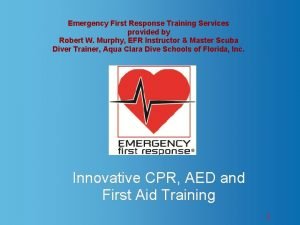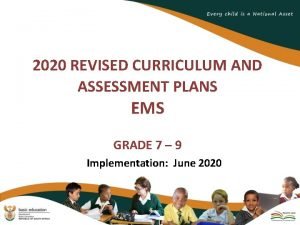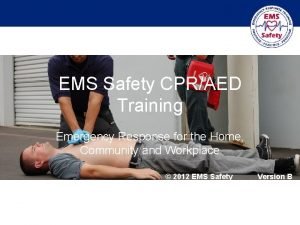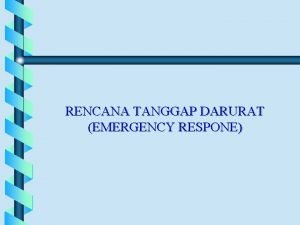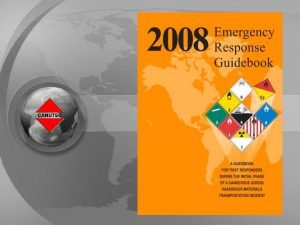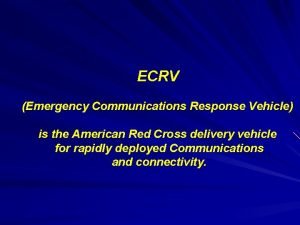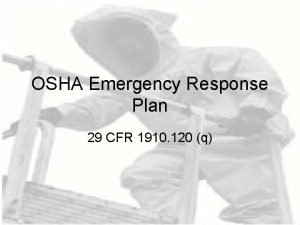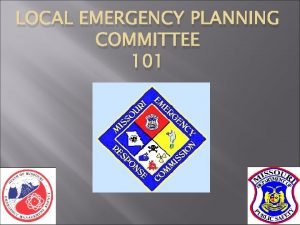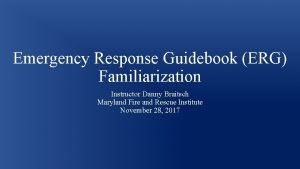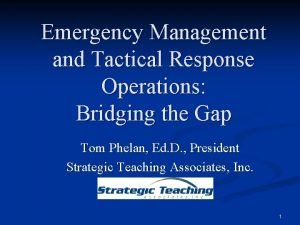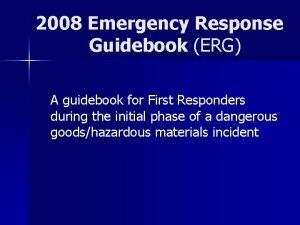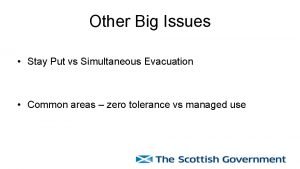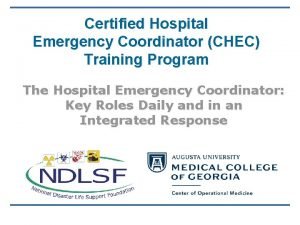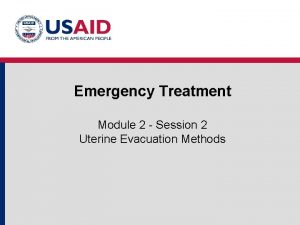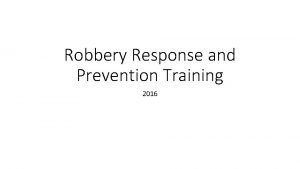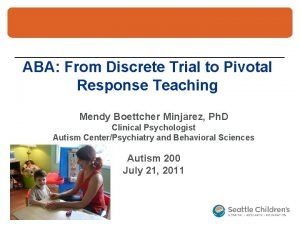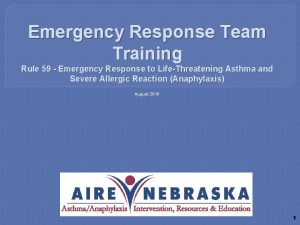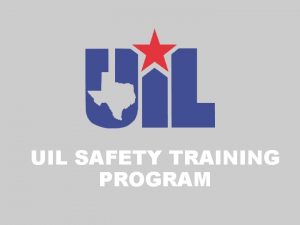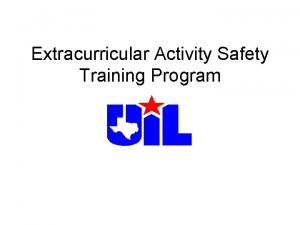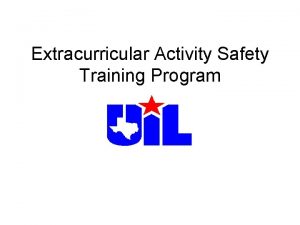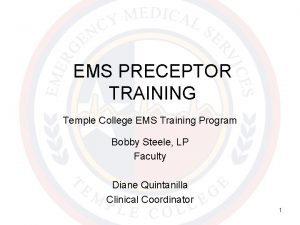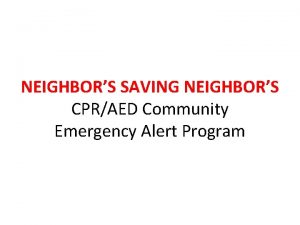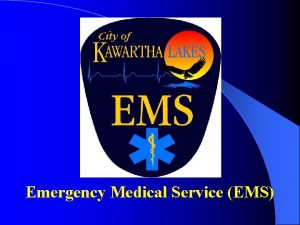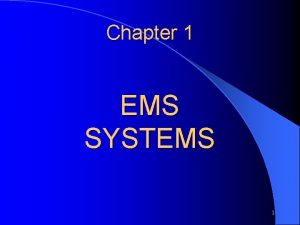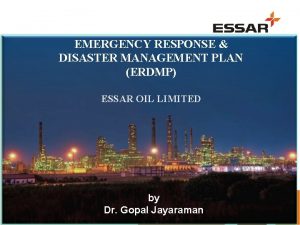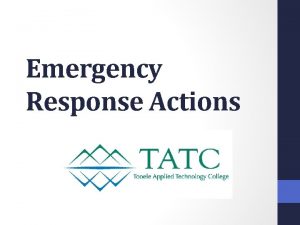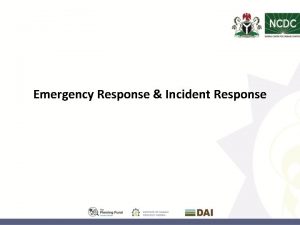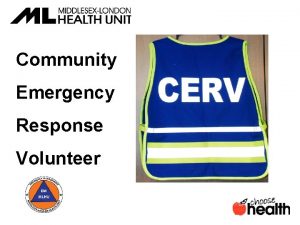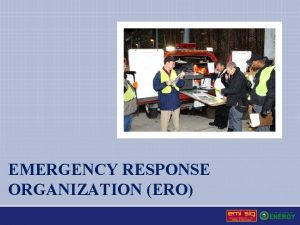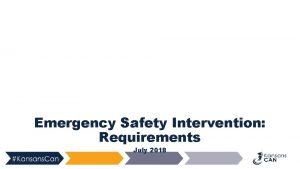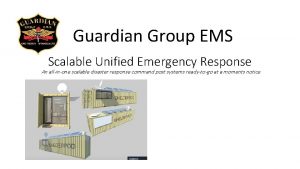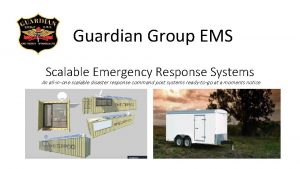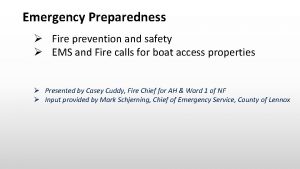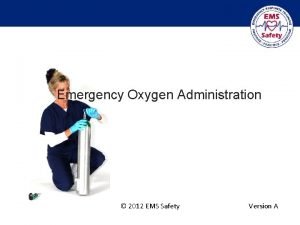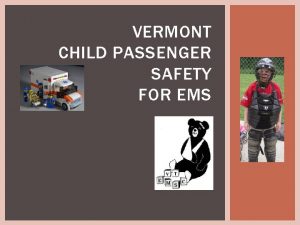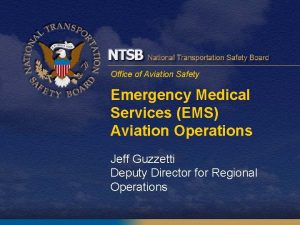EMS Safety CPRAED Training Emergency Response for the













































































































































- Slides: 141

EMS Safety CPR/AED Training Emergency Response for the Home, Community and Workplace © 2012 EMS Safety Version B

INTRODUCTION CPR/AED for Community Rescuers 2

What we will learn today • • • Quickly recognize an emergency CPR on an adult victim CPR on a child and infant victim* AED use* Emergency response – Heart Attack – Stroke – Choking *Optional Topic CPR/AED for Community Rescuers Intro 3

Certification Requirements • • • Sign in on roster Participate in all course activities Pass written exam with 80% or more Pass skills exams Just FYI… – Cards are valid for 2 years – Let me know privately if concerns about physical requirements or any latex allergies – Participation certificates are available CPR/AED for Community Rescuers Intro 4

State & Local Requirements • Guidelines are consistent with other nationally-recognized training organizations • Follow state, local or workplace guidelines if they differ from this course • Ask state or local Emergency Medical Services (EMS) Authority about – – AED use on infants Asthma inhalers Epinephrine auto-injectors Use of aspirin for heart attack signs and symptoms CPR/AED for Community Rescuers Intro 5

CHAIN OF SURVIVAL CPR/AED for Community Rescuers 6

Key Concepts • Leading cause of death in U. S. is Heart Disease • Heart disease leads to Sudden Cardiac Arrest (SCA) – – Heart suddenly stops beating Person is unresponsive Breathing stops Brain damage in 4 – 6 min w/o CPR • The Chain of Survival is a series of actions that gives SCA victims the best chance of survival CPR/AED for Community Rescuers Chain of Survival 7

5 Steps to SCA Survival What are the best actions to take immediately after Sudden Cardiac Arrest? CPR/AED for Community Rescuers 5 Steps to Survival 1. 2. 3. 4. 5. Chain of Survival Activate EMS (Call 9 -1 -1) Early CPR Early Defibrillation Early Advanced Care Post-Arrest Care 8

Activate EMS (Call 9 -1 -1) Use cell phone or land line Activate EMS (Call 9 -1 -1) • Recognize cardiac arrest – Not responding – Chest not moving, no breathing • Don’t delay: early 9 -1 -1 linked to increased SCA survival • Send bystander if possible • If unsure, go call! CPR/AED for Community Rescuers Chain of Survival 9

Early CPR Start compressions! Early CPR • Start with Chest Compressions • Compressions restore flow of oxygen to brain • Good chest compressions linked to increased survival • Push hard and fast! CPR/AED for Community Rescuers Chain of Survival 10

Early Defibrillation Use AED when it arrives CPR/AED for Community Rescuers Early Defibrillation • Defibrillators can restart the heart of an SCA victim • Calling 9 -1 -1 gets a defibrillator to the scene • An Automated External Defibrillator (AED) is used by citizen rescuers • Some public places like airports have AEDs accessible to all rescuers Chain of Survival 11

Advanced & Post-Arrest Care Advanced Care • AKA: Advanced Life Support • Provided by paramedics, continued at hospital • Adds advanced airway management, drug therapy, cardiac monitoring to CPR • Goal: restart heart and stabilize for post-arrest care CPR/AED for Community Rescuers Post-Arrest Care • Comprehensive care once person is stabilized • Begins at hospital and continues through discharge • Provided by doctors, nurses, therapists and many others • Goal: Improve chances of continued survival with least disability Chain of Survival 12

Discussion 1. Why is activating EMS the first link in the chain of survival? 2. Are AEDs located in your community or workplace? Where? 3. Why does the bystander have the biggest impact on survival of SCA? CPR/AED for Community Rescuers Chain of Survival 13

CPR OVERVIEW CPR/AED for Community Rescuers 14

Key Concepts • Cardiac Arrest = – No heartbeat – No oxygen to brain or vital organs • CPR can: – Keep brain alive – Oxygenate vital organs – Extend the time for successful defibrillation CPR/AED for Community Rescuers CPR Overview 15

Cardiopulmonary Resuscitation Heart is squeezed between sternum and backbone CPR/AED for Community Rescuers CPR • Combines external chest compressions and rescue breathing • Breaths fill lungs • Compressions move oxygen by pumping blood • Keeps brain alive • Chest compressions are most important part CPR Overview 16

What is an AED Automated External Defibrillator (AED) What it does… • Uses voice and visual prompts • Easily guides rescuers • Analyzes heart rhythm • Determines if shock is needed • Restores normal rhythm • Provides CPR reminders CPR/AED for Community Rescuers CPR Overview 17

Ventricular Fibrillation (V-fib) V-fib to Shock to Normal V-fib present in 90% of SCA cases CPR/AED for Community Rescuers V-fib is common in SCA • Heart overwhelmed by electrical activity • Can be related to lack of oxygen • Quickly lethal • Victim unresponsive • CPR won’t stop V-fib • “Defib” is only treatment for “V-fib” CPR Overview 18

How an AED Works Power on & attach pads CPR/AED for Community Rescuers • AED detects V-fib • Sends powerful current through heart • Shock resets heart’s electrical activity • Heart may start beating normally • Like a ‘control-altdelete’ for the heart CPR Overview 19

Sum it Up • CPR restores flow of oxygen to the brain • CPR can extend time for successful AED use • The sooner an AED is used, the more likely it will work CPR/AED for Community Rescuers CPR Overview 20

The C-A-B sequence applies to victims of all ages. Learn the adult sequence first… C-A-B CPR/AED for Community Rescuers 21

Key Concepts • C-A-B stands for: – Compression – Airway – Breathing • Best sequence of rescuer actions for CPR – In first few minutes victim’s body still has oxygen-rich blood – Starting with chest compressions circulates oxygen, eliminating need to start with rescue breaths • The C-A-B sequence is used for unresponsive victims of all ages CPR/AED for Community Rescuers C-A-B 22

Establish Response, Check Breathing Hey! Are you okay? Tap and shout • If no response – Go call 9 -1 -1 – Get an AED if available – Send bystander if present Scan the chest for breathing, 5 -10 seconds • If no breathing or only gasping: START COMPRESSIONS CPR/AED for Community Rescuers C-A-B 23

C: Compressions Push Hard & Fast! CPR/AED for Community Rescuers Provide 30 Compressions • Use a firm, flat surface • Center of the chest, between nipples • Push hard: At least 2” • Push fast: At least 100 compressions per minute • Ensure full recoil: Chest expands between each compression • Minimize interruptions C-A-B 24

A: Airway Prepare for rescue breaths Quickly Open Airway • Position head using the head tilt/chin lift • Place 1 hand on forehead • Place 2 or 3 fingers of your other hand near the chin • Tilt the head back while lifting the jaw upward CPR/AED for Community Rescuers C-A-B 25

B: Breathing Give breaths carefully… 2 Rescue Breaths • • • Too much air causes vomiting CPR/AED for Community Rescuers • • • C-A-B About 1 second per breath Maintain head tilt/chin lift Pinch nose Seal the victim’s mouth with yours or use barrier Breathe into the mouth for about 1 second Watch for chest rise Lift mouth off Repeat for 2 nd breath 26

Repeat the C-A-B Sequence • Take < 10 seconds to give 2 breaths • Quickly resume chest compressions after giving rescue breaths • Continue repeating the sequence of 30 compressions, open airway, give 2 breaths • CPR is performed in cycles – 1 cycle is 30 compressions and 2 breaths (30: 2) – 5 cycles of CPR can be performed in about 2 minutes CPR/AED for Community Rescuers C-A-B 27

When to Use the AED Use AED when it’s available If 2 nd Rescuer Present • Rescuer 1 continues CPR • Rescuer 2 operates AED • Switch roles when the AED prompts to stop CPR – If no AED, switch performing CPR about every 2 minutes • Observe CPR provider & give feedback • Pushing hard/fast enough? CPR/AED for Community Rescuers C-A-B 28

Recovery Position If breathing normally… Modified H. A. IN. E. S Recovery Position • Use when – Need to leave to get help – Victim vomits Place victim on side CPR/AED for Community Rescuers C-A-B 29

Discussion • Could I really do it? CPR/AED for Community Rescuers C-A-B 30

Sum It Up • Starting CPR with chest compressions circulates the oxygen still in the blood and gives the victim the best chance of survival • Quality compressions matter • Push hard and fast • Minimize interruptions to compressions – No more than 10 seconds to give breaths • Allow the chest to fully recoil (expand) between each compression – Take your weight off the victim’s chest CPR/AED for Community Rescuers C-A-B 31

CPR BARRIERS CPR/AED for Community Rescuers 32

Key Concepts • The risk of catching a disease with rescue breaths is extremely low • It is common to be uncomfortable with the thought of giving mouth-to-mouth rescue breaths • CPR barriers can help prevent exposure to blood or body fluids • Create a barrier between the victim and rescuer while allowing for the passage of air CPR/AED for Community Rescuers CPR Barriers 33

CPR Face Mask Molded plastic mask • May require quick assembly • Covers mouth and nose • Prevents back flow of exhaled air or fluids • Select the correct size: – Base (wide end) does not extend past chin – Top (narrow end) does not extend past bridge of the nose CPR/AED for Community Rescuers CPR Barriers 34

Using a Face Mask 1. Press mask onto face 2. Lift the chin to open the airway 3. Breathe into the mask 4. Watch for chest rise with each breath CPR/AED for Community Rescuers CPR Barriers 35

CPR Face Shield Small, flexible plastic with a filter or valve CPR/AED for Community Rescuers • Fits over the mouth • Pinch the nose over or under the face shield • Stored in keychain pouch with gloves • Close to rescuer at all times CPR Barriers 36

Using a CPR Face Shield 1. Place over face with filter or valve over person’s mouth 2. Open airway 3. Pinch nose 4. Breathe into the filter or valve 5. Watch for chest rise with each breath CPR/AED for Community Rescuers CPR Barriers 37

Optional Topic Optional Segment, only required for AED certification… USING AN AED CPR/AED for Community Rescuers 38

Key Concepts • AEDs can be used on adults, children and infants • An AED has a status indicator to show if it is ready for use • Follow local protocols for age-specific AED guidelines if they differ from this course • Basic AED Sequence: – Power on the AED – Apply pads – Follow AED prompts CPR/AED for Community Rescuers Using an AED 39

Power the AED • Place AED near head • Power on AED • AED guides actions CPR/AED for Community Rescuers Using an AED 40

Apply AED Pads • Expose chest – Cut clothing – Wipe dry • Apply pads (follow pictures) – Right upper chest, just below collarbone – Lower left side of the chest • If 2 rescuers – Rescuer 1 continues CPR – Rescuer 2 operates AED CPR/AED for Community Rescuers Using an AED 41

Shock or No Shock? • After pads are applied: – AED prompts rescuer to stop CPR – AED analyzes the heart’s electrical rhythm – Do not touch or move the person • AED will state ‘shock advised’ or ‘no shock advised’ • If no shock advised, AED will prompt rescuer to resume chest compressions • If shock advised, rescuer must clear victim first CPR/AED for Community Rescuers Using an AED 42

Clear Victim and Shock Do not touch victim or clothing during a shock • Clear victim first – Loudly state, “Clear!” – Look up and down entire victim – Ensure no one touching person or clothing • Press shock button – Some AEDs shock automatically (no button) – AEDs announce when safe to resume compressions CPR/AED for Community Rescuers Using an AED 43

Resume CPR Immediately resume CPR • Start with chest compressions • AED will analyze heart rhythm every 2 minutes • If 2 nd rescuer present – Switch roles when AED prompts to stop CPR – One rescuer rests – Other rescuer gets in position for CPR – Rescuer 2 will continue to operate AED CPR/AED for Community Rescuers Using an AED 44

AED Use on Children For AED use: A child is 1 -8 years old, or less than 55 lbs. An infant is < 1 year old • Children & infants require less electrical current • Special equipment reduces amount of energy delivered – Child/Infant Pads – Energy reducer or attenuator – Pediatric key or switch • If pediatric equipment is not available, use standard equipment CPR/AED for Community Rescuers Using an AED 45

For Smaller Children or Infants • Use front-to-back AED pad placement if needed • Pads should not touch or overlap • Do not cut or fold pads to fit CPR/AED for Community Rescuers Using an AED 46

In CPR, a victim is considered an adult when signs of puberty are present. Look for facial or underarm hair on a male or signs of breast development on a female. ADULT CPR/AED for Community Rescuers 47

Key Concepts • Always check the scene for safety first • If the scene is safe, establish a response • If unresponsive and not breathing or only gasping, provide CPR using the C-A-B sequence CPR/AED for Community Rescuers Adult CPR 48

Starting CPR • Survey scene, size-up potential hazards • Tap the shoulder and shout, “Are you all right? ” • Call 9 -1 -1, get AED – Send bystander – Go yourself if alone • Scan chest for breathing (5 -10 seconds) • Start compressions if no breathing, only gasping, unsure if breathing CPR/AED for Community Rescuers Adult CPR 49

C: 30 Compressions Use a firm, flat surface • Expose chest if needed • Location: center of the chest, between nipples • Use 2 hands: – Heel of one hand on chest – Heel of other hand on top • Push hard: At least 2” down • Push fast: At least 100 per minute • Ensure full recoil • Minimize interruptions CPR/AED for Community Rescuers Adult CPR 50

A: Open Airway • Place 1 hand on the forehead – Apply firm, backward pressure with your palm – Tilt head back • Place 2 or 3 fingers of other hand near chin – Keep fingers on bony part of the jaw • Tilt the head back, lift the chin forward CPR/AED for Community Rescuers Adult CPR 51

B: Give 2 Breaths • Maintain head tilt/chin lift • Pinch the nose • Breathe into mouth for about 1 second • Watch for chest rise • Repeat for the 2 nd breath • Do not over-ventilate CPR/AED for Community Rescuers Adult CPR 52

Continue CPR Cycles of 30: 2 • If 2 rescuers, switch roles every 2 min (5 cycles) or when AED is analyzing – Rest between roles as CPR provider – Keep provider on pace (at least 100 comp/min) – Instruct compressor to push harder (at least 2”) if too shallow • Only Stop CPR if – Victim begins to move – EMS responders take over – AED prompts you to stop CPR/AED for Community Rescuers Adult CPR 53

Defibrillation • Use when available • Place near victim’s head • Power on AED • Follow prompts • Apply pads • Press shock button • Resume compressions after shock CPR/AED for Community Rescuers Adult CPR 54

Discussion 1. What is the best way to activate EMS at home? At work? 2. What do you do if the chest won’t rise with the 1 st rescue breath? 3. What is the most important part of CPR: compressions, airway management, or rescue breathing? CPR/AED for Community Rescuers Adult CPR 55

In CPR, a victim is considered a child from age 1 until puberty. CHILD CPR/AED for Community Rescuers 56

Key Concepts • Usually different cause of cardiac arrest for children and infants than for adults – Adults: Heart disease, heart attack – Children/infants: Respiratory arrest • Common causes of respiratory arrest in children: – – – Injury Poisoning Choking Drowning Asthma CPR/AED for Community Rescuers Child CPR 57

Starting CPR • Survey scene, size-up potential hazards • Tap the shoulder and shout, “Are you all right? ” • Send bystander to call 9 -1 -1, get AED • Stay with the child • Scan the chest for breathing, 5 -10 seconds • Start compressions if no breathing, only gasping, if If alone, yell for help. Stay for 2 minutes you’re unsure of CPR before leaving to call 9 -1 -1 CPR/AED for Community Rescuers Child CPR 58

C: 30 Compressions Use a firm, flat surface CPR/AED for Community Rescuers • Expose chest if needed • Location: Center of the chest, between nipples • Use 1 or 2 hands • Push hard: About 2” down • Push fast: At least 100 per minute • Ensure full recoil • Minimize interruptions Child CPR 59

A: Open Airway • Place 1 hand on the forehead – Apply firm, backward pressure with your palm – Tilt head back • Place 2 or 3 fingers of other hand near chin – Keep fingers on bony part of the jaw • Tilt the head back, lift the chin forward CPR/AED for Community Rescuers Child CPR 60

B: Give 2 Breaths • Maintain head tilt/chin lift • Pinch the nose • Breathe into mouth for about 1 second • Watch for chest rise • Repeat for the 2 nd breath • Do not over-ventilate CPR/AED for Community Rescuers Child CPR 61

Continue CPR Cycles of 30: 2 CPR/AED for Community Rescuers • If 2 rescuers, switch roles every 2 minutes (5 cycles) – Rest between roles as CPR provider – Keep provider on pace (at least 100/min) – Instruct compressor to push harder if too shallow Child CPR 62

Call 9 -1 -1 If still alone after 2 minutes, go activate EMS and get an AED if one is close by CPR/AED for Community Rescuers • Return quickly • Resume CPR until EMS takes over or the child begins to move • Use an AED as soon as it is available Child CPR 63

In CPR, a victim is considered an infant up to 1 year old. INFANT CPR/AED for Community Rescuers 64

Key Concepts • Common causes of respiratory arrest in infants: – Choking – Injury – Sudden Infant Death Syndrome (SIDS) – Respiratory illness CPR/AED for Community Rescuers Infant CPR 65

Starting CPR • Survey scene, size-up potential hazards • Tap bottom of foot and shout • Send bystander to call 9 -1 -1, get AED • Scan the chest for breathing, 5 -10 seconds • Start compressions if no If alone, yell for help. Stay for 2 breathing, only gasping, or if you’re unsure minutes of CPR before leaving to call 9 -1 -1 CPR/AED for Community Rescuers Infant CPR 66

C: 30 Compressions Use a firm, flat surface CPR/AED for Community Rescuers • Expose chest if needed • Location: Center of chest, just below nipple line • Use 2 fingers • Push hard: About 1½” down • Push fast: At least 100 per minute • Ensure full recoil • Minimize interruptions Infant CPR 67

A: Open Airway • Place 1 hand on the forehead – Apply firm, backward pressure with your palm – Tilt head back Do not tilt the head too far back. Overextending the airway can actually close it! CPR/AED for Community Rescuers • Place 2 or 3 fingers of other hand near chin • Tilt the head back, lift the chin forward • Maintain a neutral or slightly extended position Infant CPR 68

B: Give 2 Breaths Breathe into mouth and nose at the same time CPR/AED for Community Rescuers • Maintain head tilt/chin lift • Breathe into mouth and nose about 1 second • Watch for chest rise • Repeat for the 2 nd breath • Do not over-ventilate Infant CPR 69

Continue CPR Cycles of 30: 2 • If 2 rescuers, switch roles every 2 minutes (5 cycles) – Rest between roles as CPR provider – Keep provider on pace (at least 100/min) – Instruct compressor to push harder if too shallow CPR/AED for Community Rescuers Infant CPR 70

Call 9 -1 -1 If still alone after 2 minutes, call 9 -1 -1 CPR/AED for Community Rescuers • Take the infant with you if you have to leave • Resume CPR until EMS takes over or the infant begins to move • Use an AED as soon as it is available Infant CPR 71

SPECIAL CONSIDERATIONS CPR/AED for Community Rescuers 72

Key Concepts • Certain situations may affect response to cardiac arrest • Keep CPR going as long as possible • In cold environments – A hypothermic victim may have more time before brain damage occurs – Do not assume it is too late to begin CPR • Electrical shock may cause immediate respiratory or cardiac arrest – Scene safety is most important – Shut off the power source first • Make sure scene is safe before approaching victim CPR/AED for Community Rescuers Special Considerations - CPR 73

Vomiting • A person in cardiac arrest will often vomit from over-ventilation • If the victim vomits, roll person to side, sweep out mouth, roll back, continue CPR • Reduce risk with rescue breaths by providing just enough air to cause the chest to rise CPR/AED for Community Rescuers Special Considerations - CPR 74

When to Stop CPR • Victim begins to move or breathe • AED directs you to stop • Scene becomes unsafe • Physically exhausted and unable to continue • Professional rescuers arrive and are ready to take over • Victim is pronounced dead by a qualified person CPR/AED for Community Rescuers Special Considerations - CPR 75

Compression-only CPR Only for adult victims CPR/AED for Community Rescuers • Continuous chest compressions without rescue breaths • Exchange of oxygen occurs with the force of compressions • Taught by dispatchers to untrained rescuers who call 9 -1 -1 • Also used for adult victim if rescuer is unable or unwilling to provide rescue breaths Special Considerations - CPR 76

Nose and Stoma Rescue Breathing Mouth-to-Nose • Use if victim’s mouth or jaw is severely damaged • Holding mouth closed prevents air from escaping • Make a seal and exhale into victim’s nose CPR/AED for Community Rescuers Mask-to-Stoma • Stoma: surgical opening at base of throat • Can be performed with mask or mouth-to-stoma • Pinch nose closed if possible to prevent air escape • Make a seal around the stoma and exhale; watch for chest rise Special Considerations - CPR 77

Optional Topic Optional segment, only required for AED certification SPECIAL CONSIDERATIONS AED 78

Key Concepts • There are 3 situations to consider when applying AED pads that may alter rescuer’s actions: – A very hairy chest – An implanted device (e. g. pacemaker) – A medication patch CPR/AED for Community Rescuers Special Considerations - AED 79

Very Hairy Chest • A lot of chest hair limits contact between AED pad and victim’s skin • AED may not be able to read heart rhythm • If the first set of pads is not working If only 1 set of pads is available, quickly shave the areas of pad placement before applying pads CPR/AED for Community Rescuers – Press pads firmly onto skin – Remove with a quick motion – Apply second set of pads Special Considerations - AED 80

Implanted Devices Device may appear as a small raised lump under skin • Devices may include − Pacemaker − Automated Implantable Cardioverter-Defibrillator (AICD) − Medication administration port • Most implanted devices do not affect AED pad placement. – Do not place pad directly over implanted device – Adjust pad placement at least 1” from device CPR/AED for Community Rescuers Special Considerations - AED 81

Medication Patches Medication can be embedded in an adhesive patch applied to skin • Do not place an AED pad over a medication patch – Use a gloved hand to remove the patch – Quickly wipe chest clean with a towel or cloth • Apply pads after area is wiped clean CPR/AED for Community Rescuers Special Considerations - AED 82

Storage & Maintenance • Close to trained rescuers – Near most of people, most of the time – Visible signage; easy access – Common areas easy to describe • With accessories – – – Spare adult pads Pediatric pads or adaptor CPR barrier, gloves Safety razor Absorbent towel • Inspection – – CPR/AED for Community Rescuers Special Considerations - AED Status indicator shows ‘Ready’ Pads & battery not expired No visible damage No missing accessories 83

Troubleshooting • An AED performs self checks regularly and every time it is powered on. • The AED will notify operator if problem detected • “Check pads” – Press down firmly, or replace pads w/ back up set – Check pad connection to AED • “Low Battery” – Replace battery – Even in low battery state, AED may provide several shocks – Refer to AED manufacturer for more information • Movement – Disrupts analysis of heart rhythm – When AED is analyzing, do not touch or move victim CPR/AED for Community Rescuers Special Considerations - AED 84

Sum It Up • Consider shaving a very hairy chest before pad placement • Avoid placing pads over implanted device • Remove medication patches • Store AED near trained rescuers and a phone • If a problem with AED cannot be quickly solved, discontinue AED use and resume CPR/AED for Community Rescuers Special Considerations - AED 85

Optional Topic Optional segment, only required for AED certification AED SAFETY 86

Key Concepts • Using an AED during an emergency is safe • Take precautions to maximize safety • Consider rescuer’s actions when: – Clearing the victim – Water is present – The victim is using oxygen CPR/AED for Community Rescuers AED Safety 87

What is Wrong With This Picture? CPR/AED for Community Rescuers AED Safety 88

Water Wipe chest dry before applying pads • If victim is lying in puddle of water – Move to a dryer area – Ensure rescuers not standing in water • Water on victim’s chest can interfere with defibrillation How would you make this scene safe for AED use? CPR/AED for Community Rescuers – Quickly dry chest before applying pads – A wet chest may cause electricity from AED to disperse before reaching heart • Good pad contact with dry skin provides more effective and directed shock to heart AED Safety 89

Oxygen Some people may use oxygen at home or out in community • Medical oxygen is combustible • If a person is wearing oxygen – Turn it off or remove the mask or cannula • If oxygen is being used with rescue breaths – Move it several feet from victim before shock – Resume rescue breaths with supplemental oxygen CPR/AED for Community Rescuers AED Safety 90

Discussion: How would you REACT? • Instructor-led discussion • Review workbook questions • Discuss at least 1 scenario CPR/AED for Community Rescuers REACT Discussion 91

RESPONDING TO EMERGENCIES CPR/AED for Community Rescuers 92

Key Concepts • Emergency scenes can be dangerous • Rescuers can quickly become victims • Caution and common sense can save your life CPR/AED for Community Rescuers Responding to Emergencies 93

R. E. A. C. T to an Emergency • • • R: Recognize Emergency E: Environment Safety and Size-Up A: Assess Victim C: Call for Help T: Treat Victim CPR/AED for Community Rescuers Responding to Emergencies 94

Recognize Emergency • Screams, panic; seriously ill or injured person; victim or bystanders agitated or threatening • Suspicious environment; collision or stopped vehicle; environmental hazard • Remain calm; stay aware of your own safety • Consider resources and options CPR/AED for Community Rescuers Responding to Emergencies 95

Environment Safety • Size-up the scene from a safe distance – – – Blood and body fluids: Use personal protective equipment Traffic: Use car to protect scene; use bystanders to stop traffic Fire or smoke: Do not enter; focus on escape; stay low Hazardous chemicals: Leave the area immediately Confined space: Do not enter! Hostile environment: Do victim or bystanders appear agitated or threatening? • Size-up the victim – – How many? What is their general condition? Identify cause of illness or injury If more than 1 victim, decide who needs help most. If unsure, help person closest to you. • Activate EMS now if the scene is dangerous or if there is an obvious life-threatening injury or illness. CPR/AED for Community Rescuers Responding to Emergencies 96

Assess Victim & Call for Help • Assess the victim – Go to the victim’s side – Assess response and breathing – Life-threatening illness or injury • Call for help – Shout for help – Call 9 -1 -1 or your emergency response # • If not sure it’s an emergency? – Activate EMS – Dispatcher will ask questions to determine if an emergency CPR/AED for Community Rescuers Responding to Emergencies 97

Treat Victim • Treat life-threatening conditions first – If no breathing or only gasping, begin CPR – If severe bleeding, control with direct pressure • Treat victim in position found • Only move victim if – Danger – Need to position for essential care CPR/AED for Community Rescuers Responding to Emergencies 98

Calling 9 -1 -1 • When you call 9 -1 -1, dispatcher will ask – – Name, location, call back phone # What happened Number of victims and general condition What aid is being given • Follow instructions, and always hang up last • When EMS responders arrive – Continue care until told to stop – Tell EMS what time event occurred, what time you arrived, and what care has been given CPR/AED for Community Rescuers Responding to Emergencies 99

Rescuer Stress • Normal to feel stress after incident • Each rescuer responds differently to stress • Don’t ignore post-traumatic stress, manage it – Talk about your feelings – Eat properly – Avoid alcohol, drugs, caffeine – Exercise – Get enough rest Obtain professional help if needed • Don’t judge yourself for your actions CPR/AED for Community Rescuers Responding to Emergencies 100

LEGAL ISSUES CPR/AED for Community Rescuers 101

Key Concepts • Some people have a duty to respond to an emergency • Other people respond voluntarily • Voluntary responders are protected by the Good Samaritan Law • Maintain skills to stay informed on current practices CPR/AED for Community Rescuers Legal Issues 102

Good Samaritan Law Protects voluntary responders from civil liability CPR/AED for Community Rescuers • Respond voluntarily • Not getting paid to respond • Provide care with good intentions • Stay within limits of training • Not reckless or careless • Do not abandon victim after beginning care Legal Issues 103

Gaining Consent Get consent from victim before beginning care • State name, training, & care plan • Ask if you can help • Types of Consent – Expressed: expresses desire for aid – Implied: unresponsive person, unattended minor – Minor’s consent: A parent or legal guardian gives consent • Right to Refuse Care – Can refuse care at any time – Observe situation from a distance, call 9 -1 -1 if needed • Right to Privacy – Do not give out information to coworkers or bystanders – Give information to EMS responders and to supervisor CPR/AED for Community Rescuers Legal Issues 104

PROTECTION FROM INFECTION CPR/AED for Community Rescuers 105

Key Concepts • The OSHA Bloodborne Pathogens Standard requires the employer to help protect you from exposure to BBP • Use precautions with every emergency • Hand washing is an important part of infection control CPR/AED for Community Rescuers Protection from Infection 106

Bloodborne Pathogens Bloodborne pathogens are disease-causing microorganisms in blood • Most serious: – HIV – Hepatitis B – Hepatitis C • May be transmitted during an emergency when – Giving first aid – Handling contaminated sharps – Cleaning a blood spill • Routes of transmission – Splash to eye, mouth or nose – Opening in skin (cut, scab, rash, hangnail) CPR/AED for Community Rescuers Protection from Infection 107

Universal Precautions • Assume all blood and body fluids are infectious, except sweat • Take precautions with all victims, even children • Use personal protective equipment – – Disposable gloves Gown Mask, goggles or face mask CPR barrier • Wash hands thoroughly immediately after glove removal • If no water, use hand sanitizer, then wash ASAP CPR/AED for Community Rescuers Protection from Infection 108

What To Do If You’re Exposed Follow Exposure Control Plan Hand Washing Technique • Wash hands and any exposed area as soon as possible • Use soap and warm water • Scrub thoroughly for at least 20 seconds • Rinse well • Immediately remove gloves • Wash thoroughly with soap and water CPR/AED for Community Rescuers Protection from Infection 109

Removing Soiled Gloves 1. Pinch base of glove, peel off slowly, hold in other hand 2. Slip 1 or 2 fingers inside other glove, carefully peel off so that it is inside out 3. Dispose in proper, leak-proof container CPR/AED for Community Rescuers Protection from Infection 110

Cleaning After an Emergency Wear personal protective equipment CPR/AED for Community Rescuers • Clean spill with paper towels or an absorbent powder • Pick up sharp objects or broken glass with tongs or brush and dustpan • Disinfect with 10% bleach and water or another disinfectant • Dispose of soiled personal protective equipment according to workplace policy • Wash your hands Protection from Infection 111

Airborne Pathogens • Other diseases can be spread when an ill person coughs or sneezes • Protect yourself by: – Getting a flu vaccine – Washing your hands often – Avoiding contact when possible with people who may be contagious CPR/AED for Community Rescuers Protection from Infection 112

Sum it Up • Keep first aid kits stocked with personal protective equipment • If you don’t have personal protective equipment with you, use whatever is available: – e. g. To control bleeding, have the victim apply the pressure, or use layers of clean cloth or extra gauze CPR/AED for Community Rescuers Protection from Infection 113

HEART ATTACK CPR/AED for Community Rescuers 114

Key Concepts • Heart disease is leading cause of death in the U. S. • Heart attack can lead to cardiac arrest • More than 1. 25 million Americans have a first or recurrent heart attack every year • About 70% of the deaths from heart attack occur before the victim reaches the hospital • Call 9 -1 -1 early for any signs of heart attack CPR/AED for Community Rescuers Heart Attack 115

What is a Heart Attack? • Coronary Artery Disease – Build-up of fatty deposits in blood vessels – Coronary arteries narrow & harden over years – Vessels become blocked – CAD is preventable • What is a heart attack? – Heart pumps blood throughout the body – Coronary arteries deliver oxygenated blood to heart – A blocked coronary artery deprives the heart of oxygen – Results in death of heart muscle CPR/AED for Community Rescuers Heart Attack 116

Heart Attack Signs & Symptoms • Chest discomfort – Pain, pressure, tightness, squeezing, fullness – Discomfort may radiate to the arms, neck, back, jaw, or abdomen – Often mistaken for heartburn or indigestion • • • Pale, cool, sweaty skin Shortness of breath Dizziness, fainting or unresponsiveness Nausea, vomiting Unexplained fatigue CPR/AED for Community Rescuers Heart Attack 117

Emergency Care for Heart Attack 1. 2. 3. 4. Call 9 -1 -1, get AED if available Position of comfort, usually sitting Calm, reassure person Offer 1 adult or 2 baby aspirin for victim to chew a. No allergy to aspirin, signs of stroke, or recent bleeding problems b. Make sure victim is alert and can swallow 5. Check breathing if victim becomes unresponsive a. If no breathing or only gasping, begin compressions b. Use the AED when it arrives CPR/AED for Community Rescuers Heart Attack 118

Don’t Delay Calling 9 -1 -1 • • If any signs and symptoms are present If the symptoms fade and return To give aspirin Calling 9 -1 -1 can mean difference between heart attack & cardiac arrest • Professional Rescuers can provide treatment before cardiac arrest occurs CPR/AED for Community Rescuers Heart Attack 119

Unusual Symptoms • Be alert to other Women, diabetics, elderly may not symptoms have classic ‘chest discomfort’ – – Extreme fatigue Nausea, vomiting Shortness of breath Pain in jaw, neck, arm(s) or abdomen • Women are as likely to have a heart attack as men • May not report symptoms • Often misdiagnosed CPR/AED for Community Rescuers Heart Attack 120

Use of Aspirin Offer 1 adult or 2 baby aspirin for victim to chew • Chewing aspirin gets it into the bloodstream faster than swallowing it • Aspirin thins blood, reduces ability to clot • Ensure no allergy to aspirin, signs of stroke, or recent bleeding problems • Victim must be alert and Learn your state, local & workplace able to swallow guidelines for use of aspirin. CPR/AED for Community Rescuers Heart Attack 121

STROKE CPR/AED for Community Rescuers 122

Key Concepts • Stroke is 3 rd leading cause of death in U. S. • 800, 000 strokes each year in the U. S. • Call 9 -1 -1 early for any signs of stroke CPR/AED for Community Rescuers Stroke 123

What is a stroke? • A stroke is like a heart attack occurring in the brain • Caused by a clot or bleed in the brain • Symptoms may be minor or severe • Many survivors are permanently impaired and struggle with daily activities CPR/AED for Community Rescuers Stroke 124

Stroke Signs & Symptoms • Sudden onset • Weakness or numbness of arm or leg, usually on one side of body • Facial droop or paralysis • Difficulty speaking • Difficulty eating, swallowing, or managing secretions • Loss of balance or coordination, difficulty walking • Confusion, anxiety, unresponsiveness • Changes in sensation • Severe headache or dizziness • Change in vision • Temporary symptoms may be a baby stroke CPR/AED for Community Rescuers Stroke 125

Emergency Care for Stroke 1. Call 9 -1 -1 (activate EMS) 2. Protect the airway a. Place in the recovery position to allow fluids to drain if needed 3. Calm and reassure victim 4. Note time that symptoms began 5. If person is unresponsive a. Check for breathing b. Start compressions if needed CPR/AED for Community Rescuers Stroke 126

Don’t Delay Calling 9 -1 -1 • • Call 9 -1 -1 immediately for signs of stroke Do not wait to see if symptoms go away Do not drive to hospital The time it takes to call 9 -1 -1 is critical – Some strokes treated with clot-busting medication (fibrinolytic therapy) – Same as with a heart attack – Only effective in the first few hours of a stroke • Early recognition of stroke can make difference between life and death or between complete recovery and lifelong disability CPR/AED for Community Rescuers Stroke 127

STR: Smile, Talk, Reach Assessment • Smile: Ask person to smile. – Look for uneven smile or facial droop • Talk: Ask person to repeat a common phrase. – Listen for slurred or incorrect words • Reach: Ask person to close eyes and raise arms. – Look for arm drift or weakness on one side CPR/AED for Community Rescuers Stroke 128

ADULT OR CHILD CHOKING CPR/AED for Community Rescuers 129

Key Concepts • Choking is a preventable emergency • Most choking incidents occur in children younger than 5 years old • Treatment is the same for an adult or child • Act quickly! Severe choking results in death if not treated • Differentiate between choking and other emergencies (heart attack, asthma, seizure, drug overdose) • Was person – – Talking or drinking alcohol while eating Eating too fast or not chewing food completely Wearing dentures while eating (hard to tell if food is chewed) Walking or running while eating or chewing gum • Universal sign of choking: 1 or both hands at throat CPR/AED for Community Rescuers Adult/Child Choking 130

Mild Obstruction Airway is partially blocked • If person can forcefully cough or speak, do not interfere • Forceful coughing is the best way to relieve an obstruction • Ask, “Are you choking? ” – If can cough or speak, encourage coughing – Watch for progression to severe obstruction • Send someone to call 91 -1 if coughing is prolonged CPR/AED for Community Rescuers Adult/Child Choking 131

Severe Obstruction Airway is completely blocked and person cannot breathe • Use abdominal thrusts • Ask, “Are you choking? ” • If nods or can’t speak: 1. 2. 3. 4. 5. 6. CPR/AED for Community Rescuers Adult/Child Choking Say you are going to help Stand behind person & reach under arms Place 1 fist just above navel, thumb side in Grasp fist with other hand Give quick upward thrusts until object comes out or the person can breathe or cough Send bystander to call 91 -1 if cannot quickly clear obstruction 132

Unresponsive Choking Person • Lower person to ground • Send a bystander to call 9 -1 -1 • If alone with adult victim, go call 9 -1 -1 now • Perform CPR • Look in mouth after each set of compressions – If object is seen, remove it – Do not ‘blind sweep’ mouth • If alone with a child or infant, go call 9 -1 -1 after 2 min. of CPR/AED for Community Rescuers Adult/Child Choking 133

Pregnant or Larger Victim Use Chest Thrusts • Stand behind person • Reach around chest, under arms • Place one fist in center of the chest – Same location as chest compressions • Grasp fist with other hand • Perform continuous backward thrusts CPR/AED for Community Rescuers Adult/Child Choking 134

Choking Prevention Tips • Eat slowly and chew food completely • Do not talk or laugh with food in your mouth • Adults: Don’t drink too much alcohol while eating; make sure dentures fit well • Children: Cut food into small pieces; cut round food into halves or quarters • Protect young children from objects small enough to fit through center of toilet paper roll • Keep children seated and supervised at mealtime CPR/AED for Community Rescuers Adult/Child Choking 135

INFANT CHOKING CPR/AED for Community Rescuers 136

Key Concepts • Choking is a preventable emergency • Most choking incidents occur in children younger than 5 years old • Treatment for infants is different than for adults and children CPR/AED for Community Rescuers Infant Choking 137

Signs of Infant Choking • Signs of Choking – – – Unable to cry or cough effectively Difficulty or no breathing Wheezing or high-pitched sounds Bluish color skin Bulging or tearing eyes Panic or distressed facial expressions • Mild Obstruction: Infant able to cough or cry – – Do not interfere Observe for progression to severe obstruction Do not leave the infant Call 9 -1 -1 if unsure CPR/AED for Community Rescuers Infant Choking 138

Severe Obstruction • Send bystander to call 9 -1 -1 – Stay with infant if alone • Sit or kneel • Hold face down & provide 5 back slaps • Turn face up & provide 5 chest thrusts • Repeat sequence until relieved or unresponsive CPR/AED for Community Rescuers Infant Choking 139

Unresponsive Choking Infant 1. Use CPR to remove object 2. Send bystander to call 9 -1 -1 3. Perform CPR with added step of looking in mouth after compressions 4. Continue CPR until infant begins to breathe 5. Call 9 -1 -1 after 2 minutes if still alone CPR/AED for Community Rescuers Infant Choking 140

Discussion: How would you REACT? • Instructor-led discussion • Review workbook questions • Discuss at least 1 scenario CPR/AED for Community Rescuers REACT Discussion 141
 Emergency response training services
Emergency response training services General ledger grade 9
General ledger grade 9 Safety care certification
Safety care certification Ems safety cpr
Ems safety cpr Rencana tanggap darurat
Rencana tanggap darurat What is the blue section of the erg
What is the blue section of the erg Ercp emergency response
Ercp emergency response Emergency communications response vehicle
Emergency communications response vehicle Cert sing
Cert sing Utm emergency response plan
Utm emergency response plan Osha 1910 120
Osha 1910 120 Missouri emergency response commission
Missouri emergency response commission Erg 2016
Erg 2016 Emergency disaster tactical response
Emergency disaster tactical response Erg blue section
Erg blue section Walmart emergency response system
Walmart emergency response system Erp emergency response plan
Erp emergency response plan Emergency response tool
Emergency response tool Natural response and forced response
Natural response and forced response What is natural response
What is natural response Primary immune response and secondary immune response
Primary immune response and secondary immune response Emergency evacuation training
Emergency evacuation training Chec certification
Chec certification Emergency evacuation training
Emergency evacuation training Iso 22301 utbildning
Iso 22301 utbildning Novell typiska drag
Novell typiska drag Tack för att ni lyssnade bild
Tack för att ni lyssnade bild Ekologiskt fotavtryck
Ekologiskt fotavtryck Varför kallas perioden 1918-1939 för mellankrigstiden
Varför kallas perioden 1918-1939 för mellankrigstiden En lathund för arbete med kontinuitetshantering
En lathund för arbete med kontinuitetshantering Särskild löneskatt för pensionskostnader
Särskild löneskatt för pensionskostnader Tidböcker
Tidböcker A gastrica
A gastrica Förklara densitet för barn
Förklara densitet för barn Datorkunskap för nybörjare
Datorkunskap för nybörjare Boverket ka
Boverket ka Debattartikel struktur
Debattartikel struktur Autokratiskt ledarskap
Autokratiskt ledarskap Nyckelkompetenser för livslångt lärande
Nyckelkompetenser för livslångt lärande Påbyggnader för flakfordon
Påbyggnader för flakfordon Tryck formel
Tryck formel Publik sektor
Publik sektor Kyssande vind analys
Kyssande vind analys Presentera för publik crossboss
Presentera för publik crossboss Jiddisch
Jiddisch Kanaans land
Kanaans land Treserva lathund
Treserva lathund Fimbrietratt
Fimbrietratt Claes martinsson
Claes martinsson Centrum för kunskap och säkerhet
Centrum för kunskap och säkerhet Verifikationsplan
Verifikationsplan Mat för idrottare
Mat för idrottare Verktyg för automatisering av utbetalningar
Verktyg för automatisering av utbetalningar Rutin för avvikelsehantering
Rutin för avvikelsehantering Smärtskolan kunskap för livet
Smärtskolan kunskap för livet Ministerstyre för och nackdelar
Ministerstyre för och nackdelar Tack för att ni har lyssnat
Tack för att ni har lyssnat Mall för referat
Mall för referat Redogör för vad psykologi är
Redogör för vad psykologi är Stål för stötfångarsystem
Stål för stötfångarsystem Atmosfr
Atmosfr Borra hål för knoppar
Borra hål för knoppar Orubbliga rättigheter
Orubbliga rättigheter Formel gruplar
Formel gruplar Tack för att ni har lyssnat
Tack för att ni har lyssnat Rita perspektiv
Rita perspektiv Informationskartläggning
Informationskartläggning Tobinskatten för och nackdelar
Tobinskatten för och nackdelar Toppslätskivling effekt
Toppslätskivling effekt Mästare lärling modell
Mästare lärling modell Egg för emanuel
Egg för emanuel Elektronik för barn
Elektronik för barn Fredsgudinnan
Fredsgudinnan Strategi för svensk viltförvaltning
Strategi för svensk viltförvaltning Kung som dog 1611
Kung som dog 1611 Humanitr
Humanitr Romarriket tidslinje
Romarriket tidslinje Tack för att ni lyssnade
Tack för att ni lyssnade Uppställning multiplikation
Uppställning multiplikation Rim till lärare
Rim till lärare Inköpsprocessen steg för steg
Inköpsprocessen steg för steg Rbk mätning
Rbk mätning Etik och ledarskap etisk kod för chefer
Etik och ledarskap etisk kod för chefer Omprov cellprov
Omprov cellprov Myndigheten för delaktighet
Myndigheten för delaktighet Frgar
Frgar Sju principer för tillitsbaserad styrning
Sju principer för tillitsbaserad styrning Läkarutlåtande för livränta
Läkarutlåtande för livränta Karttecken punkthöjd
Karttecken punkthöjd Ramsa geometriska former
Ramsa geometriska former Vishnuiter
Vishnuiter Var finns arvsanlagen
Var finns arvsanlagen Bris för vuxna
Bris för vuxna Bamse för de yngsta
Bamse för de yngsta Armed robbery response training
Armed robbery response training Example of pivotal response training
Example of pivotal response training Coordinated community response training
Coordinated community response training Hát kết hợp bộ gõ cơ thể
Hát kết hợp bộ gõ cơ thể Slidetodoc
Slidetodoc Bổ thể
Bổ thể Tỉ lệ cơ thể trẻ em
Tỉ lệ cơ thể trẻ em Chó sói
Chó sói Chụp tư thế worms-breton
Chụp tư thế worms-breton Hát lên người ơi alleluia
Hát lên người ơi alleluia Kể tên các môn thể thao
Kể tên các môn thể thao Thế nào là hệ số cao nhất
Thế nào là hệ số cao nhất Các châu lục và đại dương trên thế giới
Các châu lục và đại dương trên thế giới Công thức tính độ biến thiên đông lượng
Công thức tính độ biến thiên đông lượng Trời xanh đây là của chúng ta thể thơ
Trời xanh đây là của chúng ta thể thơ Mật thư tọa độ 5x5
Mật thư tọa độ 5x5 101012 bằng
101012 bằng Phản ứng thế ankan
Phản ứng thế ankan Các châu lục và đại dương trên thế giới
Các châu lục và đại dương trên thế giới Thể thơ truyền thống
Thể thơ truyền thống Quá trình desamine hóa có thể tạo ra
Quá trình desamine hóa có thể tạo ra Một số thể thơ truyền thống
Một số thể thơ truyền thống Cái miệng xinh xinh thế chỉ nói điều hay thôi
Cái miệng xinh xinh thế chỉ nói điều hay thôi Vẽ hình chiếu vuông góc của vật thể sau
Vẽ hình chiếu vuông góc của vật thể sau Biện pháp chống mỏi cơ
Biện pháp chống mỏi cơ đặc điểm cơ thể của người tối cổ
đặc điểm cơ thể của người tối cổ Ví dụ về giọng cùng tên
Ví dụ về giọng cùng tên Vẽ hình chiếu đứng bằng cạnh của vật thể
Vẽ hình chiếu đứng bằng cạnh của vật thể Vẽ hình chiếu vuông góc của vật thể sau
Vẽ hình chiếu vuông góc của vật thể sau Thẻ vin
Thẻ vin đại từ thay thế
đại từ thay thế điện thế nghỉ
điện thế nghỉ Tư thế ngồi viết
Tư thế ngồi viết Diễn thế sinh thái là
Diễn thế sinh thái là Dot
Dot Các số nguyên tố
Các số nguyên tố Tư thế ngồi viết
Tư thế ngồi viết Lời thề hippocrates
Lời thề hippocrates Thiếu nhi thế giới liên hoan
Thiếu nhi thế giới liên hoan ưu thế lai là gì
ưu thế lai là gì Sự nuôi và dạy con của hổ
Sự nuôi và dạy con của hổ Sự nuôi và dạy con của hươu
Sự nuôi và dạy con của hươu Hệ hô hấp
Hệ hô hấp Từ ngữ thể hiện lòng nhân hậu
Từ ngữ thể hiện lòng nhân hậu Thế nào là mạng điện lắp đặt kiểu nổi
Thế nào là mạng điện lắp đặt kiểu nổi What is catzoc
What is catzoc Process safety vs personal safety
Process safety vs personal safety Ind safety report
Ind safety report
